
|
|
|
>> Log Handling, Sorting and Storing |
| Receiving and Storing
|
| This section looks at how logs are unloaded and then stored within a
sawmill. Click on the following links for more specific information:
|
|
|
|
|
|
|
Hazard/Solutions:
Logs that are released improperly due to poor work practices may crush
workers.
- Release binders only from the side on which the unloader
operates, except when released by remote control devices or when the
person making the release is protected by racks or stanchions or the
equivalent.
1910.265(d)(1)(i)(c)
- Loads on which a binder is fouled by the unloading machine must have
an extra binder or metal band of equal strength placed around the load,
or the load must be secured so the fouled binder can be
safely removed.
1910.265(d)(1)(i)(d)
- The tripping mechanism that releases the stake or chocks must be on
the opposite side of the load being tripped.
1910.265(d)(1)(i)(a)
- Do not release binders on logs prior to securing with
unloading lines or other unloading devices.
1910.265(d)(1)(i)(b)
|
|
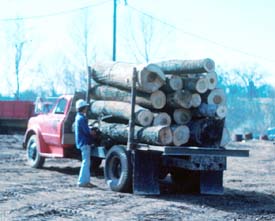
Worker releases load binders from
the side opposite the unloading side.
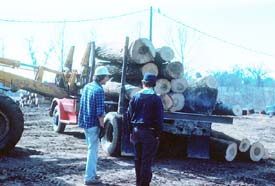
A powered industrial truck pushes
the load off the truck.
|
The following sequence of pictures depicts a safe unbinding and
unloading procedure:
|
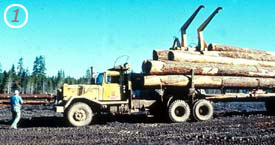
The carrier truck approaches from the far side and places
carrier mechanism over load and secures it for the approaching
truck drivers. Note: The load binders are still secured in
place.
|
|
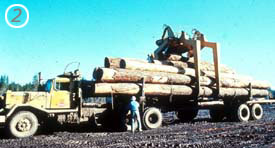
With the unloader holding the logs in place, the truck
driver releases the load binders.
|
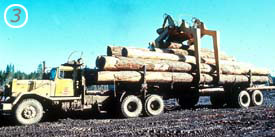
After binders are released, the
driver moves to a safe
location.
|
|

Load is then removed from the
truck for storage in the log
yard.
|
|

|
|
|
|
Hazard/Solutions:
Loads could fall and strike or crush
workers
due to equipment failure.
- Machines used for hoisting, unloading, or lowering logs must be
equipped with brakes capable of controlling or holding the maximum load
in midair.
1910.265(d)(1)(ii)(a)
- The lifting cylinders of all hydraulically operated log handling
machines must be equipped with a device that prevents uncontrolled lowering of the load or forks in case of a failure in the
hydraulic system.
1910.265(d)(1)(ii)(b)
- A limit switch must be installed on powered log handling machines to
prevent the lift arms from traveling too far in the event the control
switch is not released in time.
1910.265(d)(1)(ii)(c)
- When forklift-type machines are used to load trailers, a means of
securing the loading attachment to the fork must be installed and used.
1910.265(d)(1)(ii)(d)
- A-frames and similar log unloading devices must provide safe clearance for swinging loads,
crotch lines and spreader bar devices. 1910.265(d)(1)(ii)(e)
- Log handling machines used to stack logs or lift loads above
operator's head must be equipped with adequate overhead protection. 1910.265(d)(1)(ii)(f)
- All mobile log handling machines must be equipped with headlights
and backup lights.
1910.265(d)(1)(ii)(g)
- Unloading devices must be equipped with a horn or other noise-making device.
1910.265(d)(1)(ii)(h)
- When the operator's vision is impaired or when operating in the
vicinity of other employees, coordinate the movement of unloading
equipment with audible or hand signals.
1910.265(d)(1)(ii)(i)
|
|
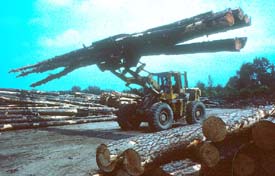
Tractor carrying logs through yard
in unstable manner
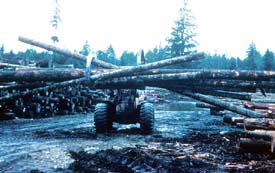
Unsafe handling of logs
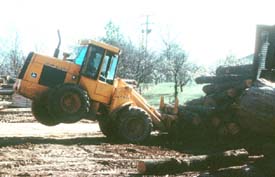
Unsafe operation of loader in log yard

Log Carrier
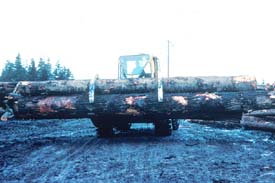
Logs are in a stable, secure position
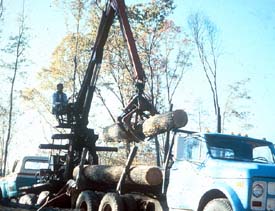
Knuckle boom unloading
logs from log truck
|
|

|
|
|
|
Hazard/Solutions:
Workers may be struck by
loads or equipment in unsafe log dumps, booms, ponds, or storage areas.
- Log dumps, booms, ponds, or storage areas used at night must be
illuminated in accordance with the requirements of American National
Standard A11.1-1965 (R-1970) Standard Practice for Industrial Lighting,
which is incorporated by reference as specified in Sec. 1910.6.
1910.265(d)(2)(i)(a)
- Log unloading areas must be arranged and maintained to provide a
safe working area.
1910.265(d)(2)(i)(b)
- Where skids are used, maintain a space adequate to clear a man's body
between the top of the skids and the ground.
1910.265(d)(2)(i)(c)
- Post signs prohibiting unauthorized foot or vehicle traffic in log
unloading and storage areas.
1910.265(d)(2)(i)(d)
|
|
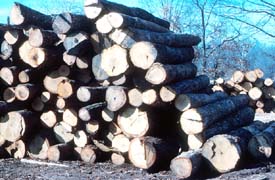
Unstable log pile creating an unsafe work area.

Logs in storage in log yard. Can you spot the
potential hazard?
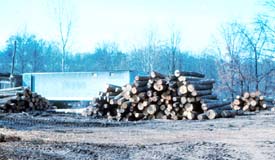
Logs in log yard
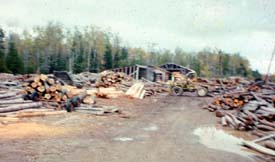
Log yard - small sawmill
|
|

|
|
|
|
Hazard/Solutions:
Logs that are stored in an unsafe
manner could move or fall, then strike or crush workers.
- Dry deck storage areas must be kept orderly and maintained
in a condition that is conducive to safe operation of mobile equipment. 1910.265(d)(2)(v)(a)
- Logs must be stored in a safe and orderly manner, and roadways and
traffic lanes must be maintained at a width adequate for safe travel of
log handling equipment. 1910.265(d)(2)(v)(b)
- Logs must be arranged to minimize the chance of
accidentally rolling
from the deck.
1910.265(d)(2)(v)(c)
|
|
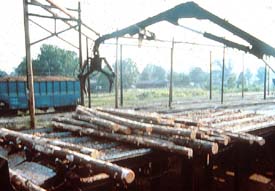
Knuckle boom loader at log deck
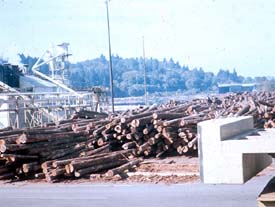
Secure, stable log piles in storage
yard
|
|

|
|
|
|
Hazard/Solutions:
Workers could be struck by
logs or crushed due to unsafe work practices.
- Safe access to the head rig must be provided.
1910.265(d)(3)(i)
- Log decks must be provided with adequate stops, chains, or
other safeguards to prevent logs from rolling down the deck onto the
carriage or its runway. 1910.265(d)(3)(ii)
- Erect a barricade to stop any log between the sawyer's stand and the log
deck. 1910.265(d)(3)(iii)
- Do not allow loose chains or other
equipment that may strike employees to hang over the log deck. 1910.265(d)(3)(iv)
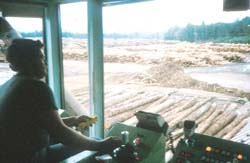
Operator inside log carrier
|
|
|
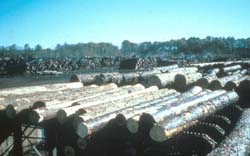
Logs on log deck
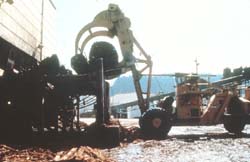
Carrier truck moves logs onto log deck.
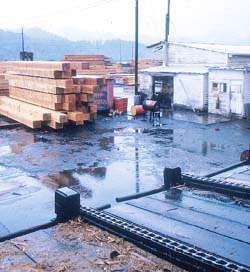
Log deck with end stops
|
|

|
|
|
| Home
| Log Handling
| Log Breakdown
| Dry
Kilns
| Lumber Storage
|
| Plant-Wide Hazards
| Definitions
| Additional
References
| User
Guide
| Credits
|
|
|
|
